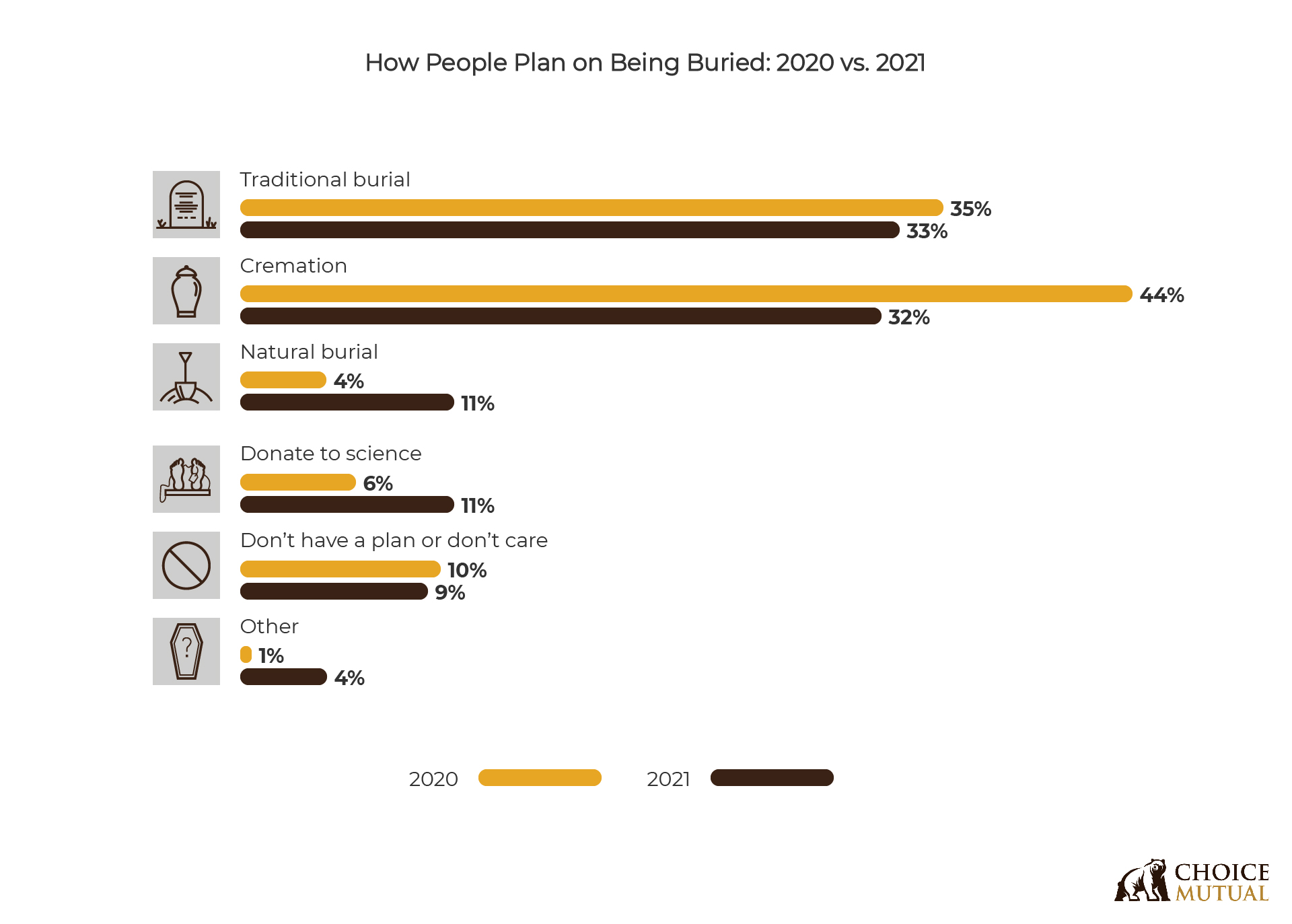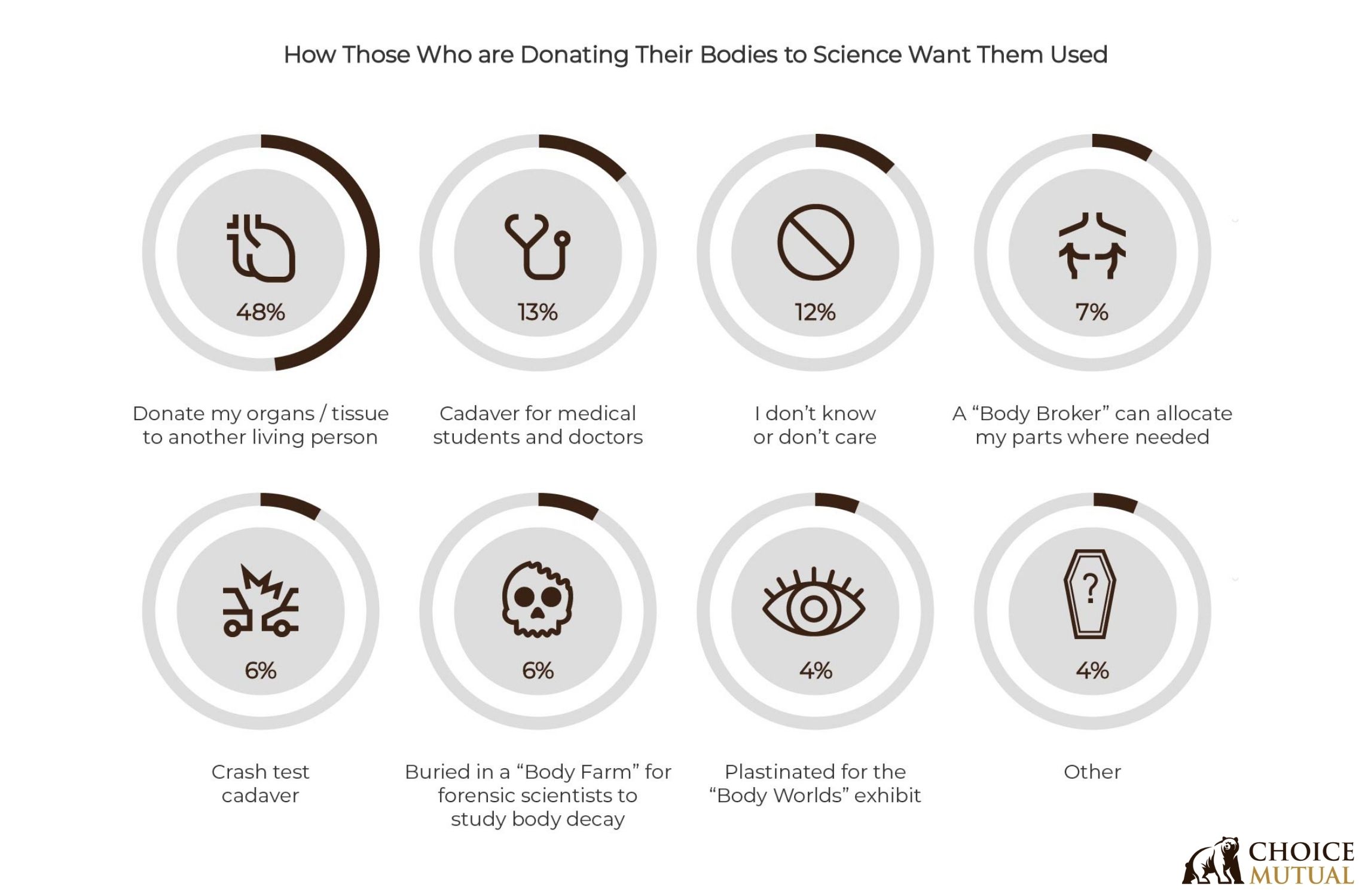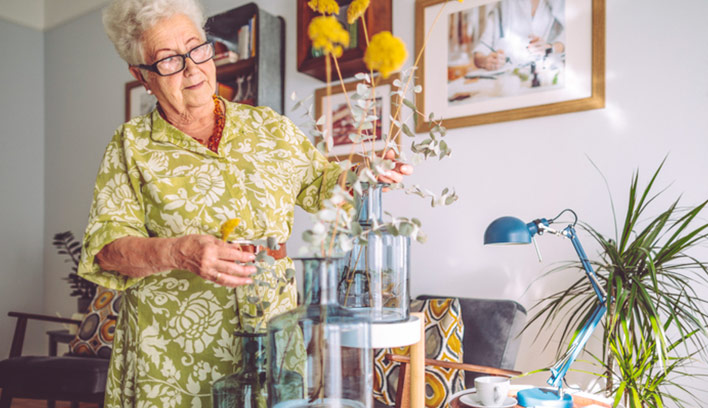n January 2020, we surveyed 1,500 Americans regarding their burial preferences. Since then, a lot has happened. The COVID-19 pandemic has impacted nearly every facet of our daily lives, including funeral decisions.
Now that many of us are resuming normalcy, we surveyed another 1,500 people to determine how America’s burial preferences have changed since our 2020 report.
How The Pandemic Impacted Americans’ Burial Decisions

More and more families are facing unexpected losses, virtual funeral services, and overall community deaths. With that in mind, it is no surprise that 37% of respondents reported that their burial/memorial choices have changed due to the pandemic. Among that 37%, over half claimed COVID-19 changed which process of body disposal they will choose.
Over 50% of Americans were invited to a funeral sometime after March 2020 and witnessed the complicated task of organizing and paying for a memorial mid-pandemic. 52% of the 37% mentioned above said COVID-19 changed how they’d like their memorial services arranged, and 43% claimed it motivated them to determine or finalize their burial plans.
Brian Waters, licensed funeral director and host of Undertaking: The Podcast, comments on this new trend: “Covid-19 has driven the United States, a country that has for the past several decades been a country that refuses to discuss death, to have this conversation with ourselves and with our family. This mere shift in mindset has allowed Americans to discover the offerings of funeral homes across the nation.”
Burial Preferences In The USA: 2020 Vs. 2021
Traditional burial emerged as the most popular funeral plan (selected by 33% of respondents), closely followed by cremation (32%). This shift is partly due to more Americans planning for a natural burial (up 7% from 2020) and donating to science (up 5% from 2020).
Joe Casper, funeral director at Casper Funeral & Cremation Services, discusses the rise in natural burials. He notes, “The natural burial option is rapidly taking its place among the most popular end-of-life options offered as conventional burial costs continue to rise. In fact, natural burials have joined cremation as a top choice for environmentally and cost-conscious individuals and families wanting to respectfully return a loved one to the earth.”
The increased interest in donating remains to science may be tied to the heavy media coverage of the healthcare industry in 2020. The heightened exposure to medically vulnerable individuals could inspire America to choose a more philanthropic burial approach.
Cremation: What To Do With The Cremains
Although traditional burial narrowly topped it as the most common burial plan, cremation is still a widely used option.
We asked Americans who plan on being cremated what they would like to do with their cremains. The responses haven’t changed much since 2020, with “ashes spread in a specific location” still being the top choice overall (28%).
This year respondents had a new option to bury their ashes in a cemetery, which ranked as the 4th most popular choice (12%).
When it comes to exactly where people want their ashes spread, the most common answer is somewhere in the great outdoors (48%), whether it be a lake, ocean, beach, or mountain. Others had more creative ideas—like scattering their remains throughout their home state or even releasing them at a concert. So beware, there may be more than just confetti raining down during the encore.
Some opt for standard options like having family keep your ashes in an urn or spreading them at your favorite vacation destination. However, 21% of Americans select “other” creative ways to utilize their cremains. The prices listed for these unique services are the lowest starting rates that we could find and do not include the additional average cremation cost ($6,260). Costs may vary depending on the selected service provider and package.
About 4% choose to spend eternity in the stars, whether launching their ashes into space (2%) or releasing them into the atmosphere in a helium-filled balloon (2%). These services start at $2,500 and $1,000, respectively. Others prefer a more permanent approach, like mixing their ashes into tattoo ink. That way, a loved one is always with them (starting around $100).
See the 2020 report for further explanation on these creative cremation options.
Donate To Science
The 11% of Americans who plan to donate their bodies to science selected how they would like their remains used, given they have the choice.
Donate my organs/tissue to another living person – 48%
According to a CNN report, 19 people die daily waiting for organ donation such as a kidney, heart, or lung. Learn more about organ donation.
Cadaver for medical students and doctors – 13%
Americans have the option to will their body to a specific University or Hospital to be used by medical students or doctors for research. Specialists recommend that you prepare your loved ones for your plans and consult with the respective institute ahead of time.
A “body broker” can allocate my parts where needed – 7%
Groups like Science Care, MedCure, and BioGift Anatomical serve as body brokers and pay for the shipment of corpses to their facilities. There they dismember body parts and allocate them to researchers as needed. These companies will often pay to cremate the unused remains and return them to the donors’ families. Unlike many countries, the United States has few regulations on selling donated body parts, allowing body brokers to export across the world. Demand for these bodies is high in countries where religious traditions or laws prohibit the dissection of the dead. (Source)
Crash test cadaver – 6%
Cadaver testing is widely responsible for modern car safety. The National Highway Traffic Safety Administration funds cadaver tests at universities across the nation. The data gained from this research is shared with automakers and used to advance modern safety features. You can contact a university near you to determine if they need donations for crash tests. (Source)
Buried in a “body farm” for forensic scientists to study body decay – 6%
The “Body Farm” is a 2.5-acre plot of land in Knoxville, Tennessee. The Anthropology Research Facility uses this property to bury over 4,000 human donors to study how bodies decompose under different conditions. This research helps law enforcement officials advance their understanding of essential principles, such as body identification and time of death analysis. Read more about the donation process. (Source)
Plastinated for the “body worlds” exhibit – 4%
Visitors to the Body Worlds exhibit can learn about anatomy, physiology, and health through the lifelike displays of plastinated bodies. Read the 2020 report to learn more about the process of plastination. At this time, the organization is not accepting new donor applications. Visit the Body Worlds website for more information on the exhibit and updates on their donation process.
Why America Chooses Their Burial Plans
Many of us understand that our burial decisions affect more than just ourselves. With that in mind, Americans still say that their personal beliefs drive their funeral plans (26%). This year respondents had the option to claim that they don’t know or don’t care what influences their burial plans (18%) or that environmental reasons drive their ultimate decisions (7%).
Approximately 1 in 3 Americans would change their body disposal plan if family, religion, or money were not a factor. Of that 35%, 37% would prefer a traditional burial (with an average cost of $7,360), and 27% would choose a natural burial (starting at $3,500). For more details on the history, process, and cost of all burial methods available in the United States, review the 2020 report.
Items We Want To Take With Us
Despite being told, “you can’t take it with you,” 69% of Americans want to try. Typical keepsakes people wish to be buried with include photos of loved ones (40%), a family heirloom (24%), and remains of a pet or loved one (17% and 19% respectively). Others want to spend eternity with rosaries, stuffed animals, notes from loved ones, dolls, or even their cell phones, so they don’t miss a text beyond the grave.
Unconventional Burial Decisions
For many of us, providing peace for our loved ones is the ultimate goal when planning our burial decisions. Solace may come in the form of a decorative urn that your family can cherish or a traditional burial plot in the company of past generations.
Alternatively, one can request the creation of jewelry using preserved teeth or bones, which 13% of Americans consider. Better yet, you can prevent your favorite tattoo from “dying” with you by getting it preserved as leather for your loved ones to display. 23% of respondents would consider this alternative memorial, starting at $1,600. Americans ages 35-44 are most on board with forever ink, with 31% saying they would consider it.
Another modern trend that some funeral homes offer is “extreme embalming,” the extensive process of preserving a body in a natural position for the duration of the funeral service. Those who select this option often request to be positioned doing their favorite things, whether sitting at a poker table, playing the drums, or even riding a motorcycle. 34% of Americans said they would consider this unique variation of an open-casket memorial. Again the 35-44 age bracket is the most interested in this option, with nearly half (46%) saying they are open to it.
How Do You Want To Be Memorialized?
Although a lot has changed since we ran the 2020 report, one thing remains the same – Americans can get pretty creative when it comes to their burial. Regardless if you choose a more traditional option or venture outside of the casket, it is crucial to take the proper steps now to prepare for the financial impact of your funeral.
Learn more about planning ahead so your family can focus on remembering you (in whichever form you choose).
Methodology
We surveyed 1,500 people in the United States about their burial preferences. We asked how they plan on being buried, what influences those plans, which items they would like to be buried with, which alternative options they would consider, and how the COVID-19 pandemic impacted their memorial plans.
Here is a detailed overview of the survey participants:
Age:
- 18–24 years: 13%
- 25–34 years: 22%
- 35–44 years: 35%
- 45–54 years: 13%
- 54 years: 17%
Gender:
- Male: 54%
- Female: 46%
Refer to the 2024 survey results for the most up-to-date version of the annual funeral preferences survey.
- Nationally licensed life insurance agent with over 15 years of experience
- Personal annual production that puts him in the top .001% out of all life insurance agents in the nation.
Anthony Martin is a nationally licensed insurance expert with over 15 years of experience and has personally served over 10,000 clients with their life insurance needs. He frequently authors entrepreneurial and life insurance content for Forbes, Inc.com, Newsweek, Kiplinger, and Entreprenuer.com. Anthony has been consulted as an expert life insurance source for dozens of high-profile websites such as Forbes, Bankrate, Reuters, Fox Business, CNBC, Investopedia, Insurance.com, Yahoo Finance, and many more.
Choice Mutual often cites third-party websites to provide context and verification for specific claims made in our work. We only link to authoritative websites that provide accurate information. You can learn more about our editorial standards, which guide our mission of delivering factual and impartial content.
-
Undertaking: The Podcast. https://www.undertakingthepodcast.com/
-
Casper Funeral & Cremation Services. https://www.casperfuneralservices.com/
-
organ donation. https://www.organdonor.gov/
-
Science Care. https://www.sciencecare.com/landing/hope-program-screening-process
-
MedCure. https://medcure.org/
-
BioGift Anatomical . https://www.biogift.org/houston-body-donations.php
-
Source. https://web.archttps://www.reuters.com/investigates/special-report/usa-bodies-export/
-
Source. https://web.archive.ohttps://www.wired.com/2010/08/how-a-cadaver-made-your-car-safer/
-
donation process. https://fac.utk.edu/body-donation/
-
Source. https://www.fbi.gov/news/stories/body-farm-20th-anniversary-032019
-
Body Worlds website. https://bodyworlds.com/
-
jewelry. https://gravemetallumjewellery.com
-
alternative memorial. https://savemyink.tattoo/













